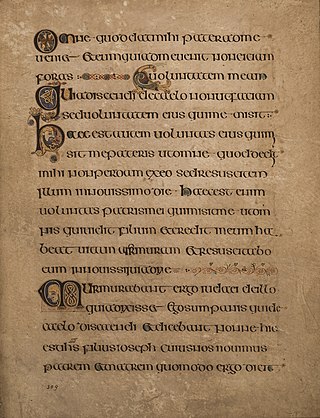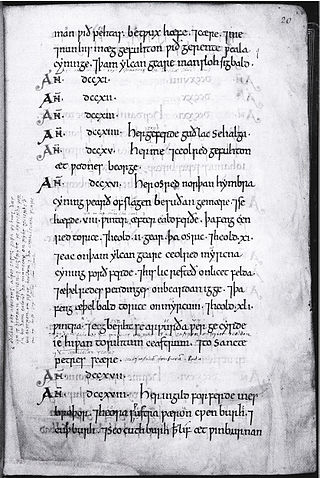
A manuscript was, traditionally, any document written by hand or typewritten, as opposed to mechanically printed or reproduced in some indirect or automated way. More recently, the term has come to be understood to further include any written, typed, or word-processed copy of an author's work, as distinguished from the rendition as a printed version of the same.
Old English literature refers to poetry and prose written in Old English in early medieval England, from the 7th century to the decades after the Norman Conquest of 1066, a period often termed Anglo-Saxon England. The 7th-century work Cædmon's Hymn is often considered as the oldest surviving poem in English, as it appears in an 8th-century copy of Bede's text, the Ecclesiastical History of the English People. Poetry written in the mid 12th century represents some of the latest post-Norman examples of Old English. Adherence to the grammatical rules of Old English is largely inconsistent in 12th-century work, and by the 13th century the grammar and syntax of Old English had almost completely deteriorated, giving way to the much larger Middle English corpus of literature.

Palaeography (UK) or paleography is the study and academic discipline of the analysis of historical writing systems, the historicity of manuscripts and texts, subsuming deciphering and dating of historical manuscripts, including the analysis of historic handwriting, signification and printed media. It is primarily concerned with the forms, processes and relationships of writing and printing systems as evident in a text, document or manuscript; and analysis of the substantive textual content of documents is a secondary function. Included in the discipline is the practice of deciphering, reading, and dating manuscripts, and the cultural context of writing, including the methods with which writing and printing of texts, manuscripts, books, codices and tomes, tracts and monographs, etcetera, were produced, and the history of scriptoria. This discipline is important for understanding, authenticating, and dating historic texts. However, in the absence of additional evidence, it cannot be used to pinpoint exact dates.

Calligraphy is a visual art related to writing. It is the design and execution of lettering with a pen, ink brush, or other writing instrument. Contemporary calligraphic practice can be defined as "the art of giving form to signs in an expressive, harmonious, and skillful manner".

Penmanship is the technique of writing with the hand using a writing instrument. Today, this is most commonly done with a pen, or pencil, but throughout history has included many different implements. The various generic and formal historical styles of writing are called "hands" while an individual's style of penmanship is referred to as "handwriting".

Uncial is a majuscule script commonly used from the 4th to 8th centuries AD by Latin and Greek scribes. Uncial letters were used to write Greek and Latin, as well as Gothic, and are the current style for Coptic and Nobiin.
The Old English Bible translations are the partial translations of the Bible prepared in medieval England into the Old English language. The translations are from Latin texts, not the original languages.

Cursive is any style of penmanship in which characters are written joined in a flowing manner, generally for the purpose of making writing faster, in contrast to block letters. It varies in functionality and modern-day usage across languages and regions; being used both publicly in artistic and formal documents as well as in private communication. Formal cursive is generally joined, but casual cursive is a combination of joins and pen lifts. The writing style can be further divided as "looped", "italic", or "connected".

Antiqua is a style of typeface used to mimic styles of handwriting or calligraphy common during the 15th and 16th centuries. Letters are designed to flow, and strokes connect together in a continuous fashion; in this way it is often contrasted with Fraktur-style typefaces where the individual strokes are broken apart. The two typefaces were used alongside each other in the germanophone world, with the Antiqua–Fraktur dispute often dividing along ideological or political lines. After the mid-20th century, Fraktur fell out of favor and Antiqua-based typefaces became the official standard in Germany.

Ancrene Wisse is an anonymous monastic rule for female anchoresses written in the early 13th century.

Western calligraphy is the art of writing and penmanship as practiced in the Western world, especially using the Latin alphabet.

Insular script is a medieval script system originating from Ireland that spread to England and continental Europe under the influence of Irish Christianity. Irish missionaries took the script to continental Europe, where they founded monasteries such as Bobbio. The scripts were also used in monasteries like Fulda, which were influenced by English missionaries. They are associated with Insular art, of which most surviving examples are illuminated manuscripts. It greatly influenced modern Gaelic type and handwriting.

John Joscelyn, also John Jocelyn or John Joscelin, (1529–1603) was an English clergyman and antiquarian as well as secretary to Matthew Parker, an Archbishop of Canterbury during the reign of Queen Elizabeth I of England. Joscelyn was involved in Parker's attempts to secure and publish medieval manuscripts on church history, and was one of the first scholars of the Old English (Anglo-Saxon) language. He also studied the early law codes of England. His Old English dictionary, although not published during his lifetime, contributed greatly to the study of that language. Many of his manuscripts and papers eventually became part of the collections of Cambridge University, Oxford University, or the British Library.
Aldred the Scribe is the name by which scholars identify a tenth-century priest, otherwise known only as Aldred, who was a provost of the monastic community of St. Cuthbert at Chester-le-Street in 970.

William Shakespeare's handwriting is known from six surviving signatures, all of which appear on legal documents. It is believed by many scholars that the three pages of the handwritten manuscript of the play Sir Thomas More are also in William Shakespeare's handwriting. This is based on many studies by a number of scholars that considered handwriting, spelling, vocabulary, literary aspects, and more.
Cambridge, Corpus Christi College, MS 178 is an English manuscript in the library of Corpus Christi College, Cambridge. The codex consists of two parts that may have been together since the thirteenth century. The first part, pp. 1–270, contains homilies for general occasions (1-163) and for festivals (164-270) and was compiled in the early eleventh century and derived from Worcester. The second part, pp. 287–457, contains Latin and Old English versions of the Rule of Saint Benedict. Both parts were glossed by The Tremulous Hand of Worcester.
The Poema Morale is an early Middle English moral poem outlining proper Christian conduct. The poem was popular enough to have survived in seven manuscripts, including the homiletic collections known as the Lambeth Homilies and Trinity Homilies, both dating from around 1200.
The Leiden Glossary is a glossary contained in a manuscript in Leiden University Library in the Netherlands, Voss. Lat. Q. 69. The lemmata (headwords) come from "a range of biblical, grammatical, and patristic texts". It is based on an Anglo-Saxon exemplar, and was prepared c. 800 in the Abbey of Saint Gall in modern-day Switzerland.
The Harley Glossary is an Anglo-Saxon glossary, mostly providing glosses on Latin words.

The Selden Carol Book is a medieval carol manuscript held by the Bodleian Library in Oxford. Along with the Trinity Carol Roll, with which it shares five contemporaneous carols and texts, it is one of the main sources for 15th century English carols, and like the Trinity Roll contains the music as the well as the texts. The inclusion of Deo Gracias Anglia referencing Henry V's victory at Agincourt in 1415 gives an indication of the date of composition of the carols.











